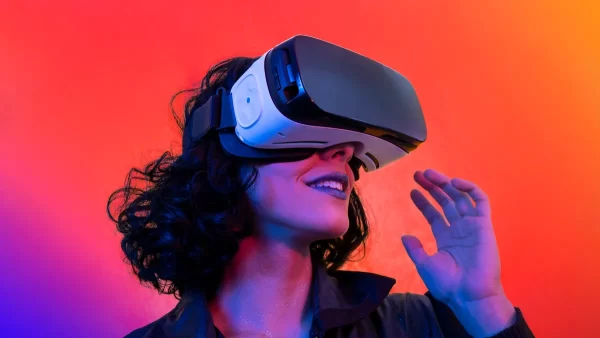The following story was originally published in 1989 in my book The Furniture of Heaven & Other Parables. Reading it now over three decades later, it strikes me as more than a little prophetic. See what you think. (Also available as a video.)
Far in the not-too-distant future, the latest invention is a video recorder that films dreams, enabling them to be played back during waking hours. Initially confined to the laboratory, dreamtech soon begins filtering down into popular culture.
The first public dreamhalls, plagued by radiation problems, had to be isolated in remote desert areas and were subject to heavy government regulation. Though hugely expensive, and barren of any other facilities or entertainment save the dreams themselves, nevertheless these resorts attracted hordes of wealthy patrons.
Most users agreed that being strapped into a laser lightbooth, complete with panacoustic sound and wrap-around holographic visuals, was a far more vivid and satisfying experience than their original dreaming had been—to say nothing of being more memorable.
With the advent of more accessible privately-owned facilities, the fad of dream-swapping arose (with all its fascinating variations) and nightmares and erotica came into great demand. The most luxurious homes, and even some private vehicles, began sporting rudimentary dream machines.
Having long outstripped drinking and drug-taking in popularity, dream-watching soon completely displaced sports and other mass recreations. In some circles, dream interpretation and prognostication became all the rage, though for the most part audiences craved not so much to know the meaning of dreams as simply to inhabit them.
In all the most contemporary stores, public buildings, schools and offices, dreamscapes became an ubiquitious feature. The term interior decoration took on a new connotation, as experts arose with impressive skills in editing and mounting dream sequences, and in selecting appropriate material to suit mood, setting, and occasion.
A movement dubbed Avant-God swept the art world, as established artists were supplanted by a new breed comprising blue collar workers, young children, schizophrenics, and the like. Ordinary and obscure folk, while devoid of conventional talent, often possessed such powerful gifts for dreaming that their eerie, elegant reveries could zoom overnight to the top of the dreamcharts. Not only that, but the familiar genres of literature, music, painting, and even theater and cinema all gradually gave way before the single spectacular art form known as Meta-Opera.
Slowly but surely, dreamtech was weaving its way into the very fabric not only of culture but of industry, politics, economics, and practical affairs. It even happened that dreams encroached on the power of the dollar as a form of currency, an abstract medium of exchange that not only lubricated but subtly controlled all the transactions of daily life.
If there was one development, however, which more than any other could be said to have transmuted the old order of things, it was the introduction of the Sleepwalker, an inexpensive portable model of dream-machine worn over the head like a helmet. Boasting spectacular fidelity, this device could ensure almost total waking immersion in dreamlife.
In no time, unprecedented numbers of young and old alike were turning to an entire lifestyle of what came to be known as dreambumming. Peddling dreams for a living, and sleepwalking their way through every conceivable activity, this new species of vagabond had no other goal but to avoid stepping even for one moment outside of the dream world. Everywhere was blazoned the slogan ESCAPE TO NIGHTSCAPE!
Meta-operas mushroomed into incredibly extravagant affairs, attended by millions of dreambums and lasting for months at a time. By combining a personalized Sleepwalker with the viewing of a public spectacle, the participant could achieve a kind of double remove from reality. All testified that the experience of marathon meta-opera was, quite simply, more real than life itself.
Naturally it had long been unfashionable to credit the actual existence of anything that might be termed reality, the real world, or objective truth. And increasingly the small minority who still clung to such antiquated notions found themselves scorned and persecuted—especially when, in a series of famous legal precedents, the courts shifted dramatically toward upholding the rights of dreamers. The new buzzword was ultra-reality, as pundits proclaimed the dawning of the so-called Reverie Revolution.
As it happened, about this time the long-predicted historic event of the Second Coming occurred, when just as He had promised the Lord Jesus Christ returned to earth in a blaze of lightning, splitting the sky asunder and riding on the clouds of heaven with great power and glory. However, coming as this did in the midst of such profound immersion in oneiric ultra-reality upon the earth, this cataclysmic appearance of the Son of God had surprisingly little effect upon the dreambums.
Oh, to be sure, people paused for a moment in their helmeted Sleepwalkers to gaze up bewildered and furious at the dazzling deity before their eyes, and all the dreamers banged their fists in a paroxysm of anguish upon the thick plexiglas of their dreams. And for a while, it is true, they literally tore out their hair and gnashed their teeth in a demand for recognition from the Lord of Glory. But alas, He knew them not.
Yet as it turned out, such grisly antics were so similar to the mass nightmare in which these multitudes were so accustomed to living, that on the whole the transition to absolute Hell was accomplished with admirable ease.
• • • • •
Suddenly, in an instant,
the Lord Almighty will come …
and then it will be as it is with a dream,
with a vision in the night—
as when a hungry man dreams he is eating,
only to awaken famished.
~Isaiah 29:5-8
• • • • •
Next Post: He’s Got the Whole World in His Hands





